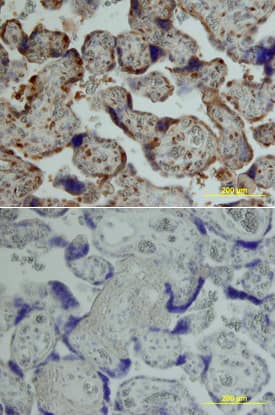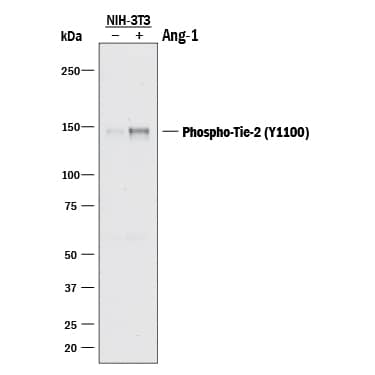Human/Mouse Phospho-Tie-2 (Y1102/Y1100) Antibody
R&D Systems, part of Bio-Techne | Catalog # AF3909

Key Product Details
Validated by
Biological Validation
Species Reactivity
Validated:
Human, Mouse
Cited:
Human, Mouse
Applications
Validated:
Immunohistochemistry, Western Blot
Cited:
Immunohistochemistry, Western Blot
Label
Unconjugated
Antibody Source
Polyclonal Rabbit IgG
Product Specifications
Immunogen
Phosphopeptide containing human Tie-2 Y1102 site
Specificity
Detects human and mouse Tie-2 when phosphorylated at Y1102 and Y1100, respectively.
Clonality
Polyclonal
Host
Rabbit
Isotype
IgG
Scientific Data Images for Human/Mouse Phospho-Tie-2 (Y1102/Y1100) Antibody
Detection of Mouse Phospho-Tie‑2 (Y1102/Y1100) by Western Blot.
Western blot shows lysates of NIH-3T3 mouse embryonic fibroblast cell line transfected with mouse Tie-2 untreated (-) or treated (+) with 600 ng/mL Recombinant Human Angiopoietin-1 (Catalog # 923-AN) for 5 minutes. PVDF membrane was probed with 1 µg/mL of Rabbit Anti-Human/Mouse Phospho-Tie-2 (Y1102/Y1100) Antigen Affinity-purified Polyclonal Antibody (Catalog # AF3909) followed by HRP-conjugated Anti-Rabbit IgG Secondary Antibody (Catalog # HAF008). A specific band was detected for Phospho-Tie-2 (Y1102/1100) at approximately 150 kDa (as indicated). This experiment was conducted under reducing conditions and using Immunoblot Buffer Group 1.Tie‑2 in Human Placenta.
Tie-2 phosphorylated at Y1102 was detected in immersion fixed paraffin-embedded sections of human placenta using Rabbit Anti-Human/Mouse Phospho-Tie-2 (Y1102/Y1100) Antigen Affinity-purified Polyclonal Antibody (Catalog # AF3909) at 15 µg/mL overnight at 4 °C. Tissue was stained using the Anti-Rabbit HRP-DAB Cell & Tissue Staining Kit (brown; Catalog # CTS005) and counterstained with hematoxylin (blue). Lower panel shows a lack of labeling if primary antibodies are omitted and tissue is stained only with secondary antibody followed by incubation with detection reagents. View our protocol for Chromogenic IHC Staining of Paraffin-embedded Tissue Sections.Applications for Human/Mouse Phospho-Tie-2 (Y1102/Y1100) Antibody
Application
Recommended Usage
Immunohistochemistry
5-15 µg/mL
Sample: Immersion fixed paraffin-embedded sections of mouse embryonic brain (15 d.p.c.) and human placenta
Sample: Immersion fixed paraffin-embedded sections of mouse embryonic brain (15 d.p.c.) and human placenta
Western Blot
1 µg/mL
Sample: NIH‑3T3 mouse embryonic fibroblast cell line transfected with mouse Tie-2 treated with Recombinant Human Angiopoietin-1 (Catalog # 923-AN)
Sample: NIH‑3T3 mouse embryonic fibroblast cell line transfected with mouse Tie-2 treated with Recombinant Human Angiopoietin-1 (Catalog # 923-AN)
Reviewed Applications
Read 1 review rated 4 using AF3909 in the following applications:
Formulation, Preparation, and Storage
Purification
Antigen Affinity-purified
Reconstitution
Reconstitute at 0.2 mg/mL in sterile PBS. For liquid material, refer to CoA for concentration.
Formulation
Lyophilized from a 0.2 μm filtered solution in PBS with Trehalose. *Small pack size (SP) is supplied either lyophilized or as a 0.2 µm filtered solution in PBS.
Shipping
Lyophilized product is shipped at ambient temperature. Liquid small pack size (-SP) is shipped with polar packs. Upon receipt, store immediately at the temperature recommended below.
Stability & Storage
Use a manual defrost freezer and avoid repeated freeze-thaw cycles.
- 12 months from date of receipt, -20 to -70 °C as supplied.
- 1 month, 2 to 8 °C under sterile conditions after reconstitution.
- 6 months, -20 to -70 °C under sterile conditions after reconstitution.
Background: Tie-2
Tie-2 (also known as TEK) is an angiogenic receptor tyrosine kinase required for the later stage of blood vessel maturation. Ligand binding induces receptor dimerization and autophosphorylation on multiple tyrosine residues. Phosphorylation of human Tie-2 at Y1102 and mouse Tie-2 at Y1100 results in the activation of PI 3‑kinase (1, 2).
References
- Kontos, C.D. et al. (1998) Mol. Cell Biol. 18:4131.
- Jones, N. et al. (1999) J. Biol. Chem. 274:30896.
Long Name
Tyrosine Kinase with Immunoglobulin and Epidermal Growth Factor Homology Domains 2
Alternate Names
CD202b, TEK, Tie2
Entrez Gene IDs
Gene Symbol
TEK
Additional Tie-2 Products
Product Documents for Human/Mouse Phospho-Tie-2 (Y1102/Y1100) Antibody
Product Specific Notices for Human/Mouse Phospho-Tie-2 (Y1102/Y1100) Antibody
For research use only
